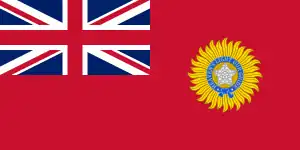| Singhbhum District | |||||||||
|---|---|---|---|---|---|---|---|---|---|
| District of the Bengal Presidency | |||||||||
| 1820–1947 | |||||||||
 Flag | |||||||||
 Singhbhum district in a 1909 map of The Imperial Gazetteer of India | |||||||||
| Capital | Chaibasa | ||||||||
| Area | |||||||||
• 1901 | 10,078 km2 (3,891 sq mi) | ||||||||
| Population | |||||||||
• 1872 | 318,180 | ||||||||
• 1881 | 453,775 | ||||||||
• 1891 | 545,488 | ||||||||
• 1901 | 613,579 | ||||||||
• 1931 | 929,802 | ||||||||
| History | |||||||||
• The Raja of Singhbhum becomes a feudatory of the British | 1820 | ||||||||
• Post-independence Singhbhum District | 1947 | ||||||||
| |||||||||
Singhbhum was a district of India during the British Raj, part of the Chota Nagpur Division of the Bengal Presidency.[1] It was located in the present-day Indian state of Jharkhand. Chaibasa was the district headquarters. Located in the southern limit of the Chota Nagpur Plateau, Singhbhum included the Kolhan estate located in its southeastern part.[2] The district has been segmented into two smaller districts, East Singhbhum and West Singhbhum.
Etymology
Singhbhum is a portmanteau of Singh and Bhum. "Singh" refers to the Singh raja of the greater Porahat state, and "Bhum" signifies the land, thereby forming the land of Singh.[3] However, the prominent inhabitants Ho tribe asserts that Singhbhum derives its name from 'Singbonga,' the supreme god of the Adivasis in the region, primarily venerated by the Kolarian ethnic tribes.[4]
Geography
It is bounded with Ranchi District in the north, with the Saraikela and Kharsawan princely states in the east, with Mayurbhanj and Keonjhar in the south as well as with Bonai and Gangpur in the southwest.[2] Singhbhum District had an area of 10,078 square kilometres (3,891 sq mi) and a population of 613,579 in 1901.[5]
History
The Singhbhum area was never invaded by either the Marathas or the Mughals. The first relationships between the Raja of Singhbhum and the British were established in 1767 when he approached the Resident at Midnapore requesting protection. In 1820 the Raja became a feudatory of the British. The state was under the political control of the Commissioner of the Bengal Presidency until 1912,[2] under the Bihar and Orissa Province until 1936 and then under Chhota Nagpur Division until the end of the British Raj.


Following the independence of India Singhbhum District became part of the Indian Union as a district of Bihar. The district has in recent decades been divided into three smaller districts, being East Singhbhum, West Singhbhum and Saraikela Kharsawan. All the three are currently part of Jharkhand state of India. The major Indian languages spoken in this region are Hindi, Bengali, Odia, Kurmali and many tribal languages.
References
- ↑ Chisholm, Hugh, ed. (1911). . Encyclopædia Britannica. Vol. 25 (11th ed.). Cambridge University Press. p. 148.
- 1 2 3 "Imperial Gazetteer2 of India, Volume 23, page 1 -- Imperial Gazetteer of India -- Digital South Asia Library". dsal.uchicago.edu. Retrieved 28 October 2022.
- ↑ Schulte-Droesch, Lea (10 September 2018). Making Place through Ritual: Land, Environment and Region among the Santal of Central India. Walter de Gruyter GmbH & Co KG. p. 11. ISBN 978-3-11-054085-7.
- ↑ Journal of Historical Research. Department of History, Ranchi University. 2003.
- ↑ Wilson Hunter, Sir William; Sutherland Cotton, James; Sir Richard Burn, Sir William Stevenson Meyer. Great Britain India Office. The Imperial Gazetteer of India. Oxford: Clarendon Press, 1908
Bibliography
- O'Malley, L. S. S. (1910). Bengal district gazetteers : Singhbhum, Saraikela and Kharsawan. Calcutta: Bengal Secretariat Book Depot. OCLC 220796364. Archived from the original on 18 January 2017.
